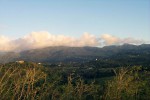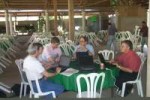The Luquillo LTER site hosted the LTER Coordinating Committee (CC) meeting 22-24 April 1999, initiating a new format designed to foster increased focus on specific LTER issues and challenges.
Eight ‘working groups’ were charged with addressing a variety of topics critical to the continued success of the LTER program. Short summaries of their reports are appended below. Please read the complete reports from the working groups and recommendations on the Web site: http://www.lternet.edu/Network/meetings.
Business Meeting
Scott Collins from the National Science Foundation discussed upcoming competitions, including Undergraduate Mentoring in Environmental Biology, Microbial Observatories, Biocomplexity, Information Technology, and a program for post-doctoral appointments in biology.
In addition, NSF is proceeding with plans for the Biodiversity Observing Network (BON) and the National Ecological Observatory Network (NEON), and further information about these initiatives will be forthcoming. A 20-year review of the LTER program is being planned, but the timing and mechanism is still under discussion.
Phil Robertson (KBS) was elected to the Executive Committee to replace David Foster, whose term had expired. The CC initiated a review of LTER priorities in response to a recommendation of the National Advisory Board (NAB) (see article, page one). The NAB has recommended that the LTER Network develop a strategic plan for outreach and education. The Network Office was assigned the responsibility of drafting this plan (se article page 4). Standardization of data collection was discussed at length.
Working Groups
1. Network Strategy for NEON
This discussion centered on activities and strategies that could increase the probability of LTER sites and their collaborators to be involved in the potential National Ecological Observing Network. As described by NSF representatives, NEON is intended to be a consortium effort. A competition will fund proposals from well-established sites that have demonstrated their success in networked research efforts. Recommendations for LTER Sites for participation in NEON are detailed on the Web site.
2. Scientific Questions for NEON
This group addressed the development a set of broad questions to guide infrastructure needs for NEON, beginning from the assumption that large-scale changes in abiotic (land use, CO2, N deposition, temperature, hydrology) and biotic dynamics have global implications for ecosystem structure and function. The group’s suggestions are detailed on the Web site. Action items include preparing a draft report from this Working group to NSF by June 1999.
3. Planning for BON
In anticipation of the upcoming competition for Biodiversity Observatories, this working group was charged with examining strategies that might benefit sites in the LTER Network. The working group developed comprehensive goals and strategies, which are detailed on the Web site. The Network Office is already in the process of implementing many of this group’s suggestions.
4. The Future of LTER Information Management
Increased funding for information technology is a priority at NSF, and the LTER Network needs to develop strategies for interacting with new initiatives. Recommendations include targeting our efforts toward LTER science priorities such as NEON, BON, and related consortia, while fostering sophisticated approaches to information and analysis and providing integrated access to diverse ecological data. Meanwhile, achieving new levels of functionality while maintaining core activities will require additional resources, and potential sources were discussed. Products of this Working Group’s strategy session are available on the Web site.
5. Evaluating the LTER Program
The NAB report (see page one) recommends that LTER develop a method for measuring its accomplishments and successes, ranging from individual sites to network-level activities. These ‘metrics’ will be valuable for NSF to use in instructing the 20 year review of the LTER program in 2001.
Contributions discussed in this working group include the use of the LTER model by other agencies, the value of scientific publications in addressing societal issues, and education at all levels. See the meeting Web site for specifics. A list of these metrics will be drafted for presentation at the next Coordinating Committee meeting.
6. The Consortium Approach
This working group discussed further development of consortia between LTER and institutions, such as those already developed with the National Center for Ecological Analysis and Synthesis, the San Diego Supercomputer Center, and the Organization of Biological Field Stations. Involvement in these consortia will allow LTER to compete for funds for projects such as information technology and training. The mission of a proposed consortium (see article, page ten) is to promote advances in ecology and systematics through cooperative initiatives in bioinformatics.
7. Interactions with other Organizations
The group recommended developing memoranda of understanding between LTER and appropriate agencies that state mutual benefits, common goals/objectives, and roles/responsibilities. Other items to consider for a meaningful MOU, and a comprehensive list of prospective agencies and organizations, as well as priorties for reasoning are on the Website.

 Enlarge this image
Enlarge this image

